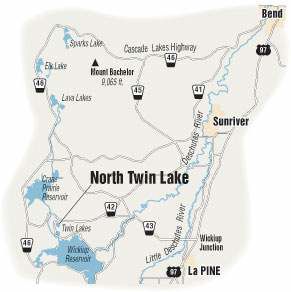Dwarf mistletoe
Published 5:00 am Friday, June 23, 2006

- Dwarf mistletoe
At first glance, it looks like any other midelevation forest in the Central Oregon Cascades. Dominated by ponderosa pine, manzanita and snowbrush, this place reeks High Desert highlands.
But look closely and follow the numbered posts and you see that all is not right with this forest. At least from a ponderosa pines perspective.
This is the newly minted Lewis Roth Dwarf Mistletoe Trail that loops above North Twin Lake and offers a series of panoramic views of the water and high Cascades in the distance. Thats a bonus. The reason this trail is here is to explain whats stunting and killing these pine trees.
Western dwarf mistletoe is the kiss of death.
The unassuming little parasite, which occurs naturally in this ecosystem, embeds itself in a pines trunk or branch, feeds on the tissue and eventually sucks the life from it.
This is not your mom and dads innocent Christmas mistletoe. Rather, this sinister dwarf variety lacks green leaves to manufacture food, according to Les Joslin of the Deschutes National Forest who oversaw the educational trail project. So they leech off our beloved pondos, altering the face of the forest.
I took the tour with Joslin, who pointed out some specimens of the opportunistic plant and provided me with details along the way.
It turns out that Western dwarf mistletoe infects only ponderosa pines (the lodgepole in the vicinity are immune). Fire has always served as an effective check on the mistletoe because it killed infected trees and branches. In the absence of fire in this area, foresters have pruned trees and plan to plant sugar pines, which are also immune.
Without such measures, Joslin explained, the dominant ponderosa pines would likely die out here, leaving mostly snowbrush, greenleaf manzanita and a radically different looking forest in their stead.
Today the Western dwarf mistletoe infestation is mostly an aesthetic and forest health issue, but in the 1950s, when timber was king, it was extremely economic as well.
It was 1952 when Lewis F. Roth, the Oregon State plant pathology professor after whom the trail is named, began a long-term research project on dwarf mistletoe at nearby Pringle Falls Experimental Forest. His ongoing research led to several effective prescriptions to limit the
parasites spread (including prescribed burning) and the development of potentially mistletoe-resistant strains of ponderosa pine that will be planted along the trail.
Roth showed up for the dedication of the trail last year and led the first tour.
He told me by phone from his Albany home that Dwarf mistletoe represents a serious long-term problem.
Dwarf mistletoe is the worst parasite of ponderosa pine, he said. Ponderosa pine is your number one species. (Mistletoe) terribly retards growth and quality.
How widespread is it?
It is everywhere in the ponderosa pine forest, Roth said. Its spread great distances by birds. It is very widespread, but it takes a long time for it to intensify.
Scientists here are taking what Roth learned and using it to protect vulnerable stands of ponderosa pine.
Theres a great view of North Twin Lake from a bench atop a knoll about halfway through the roughly a half-mile loop. And when Joslin and I were there, trout were dimpling the surface of North Twin.
From Bend, drive south past Sunriver on Highway 97 and turn right on Vandevert Road, cross the railroad tracks and go west just more than one mile. Turn left onto Huntington Road and drive one mile south, then turn right on Fall River Road and continue west about 18 miles. Turn left onto Forest Road 4260 at the sign to Twin Lakes and left again into the Twin Lakes Campground. The trailhead is near the lake on the left.
The trail is about a half-mile long.
Contact: Deschutes National Forest, 383-5300.






